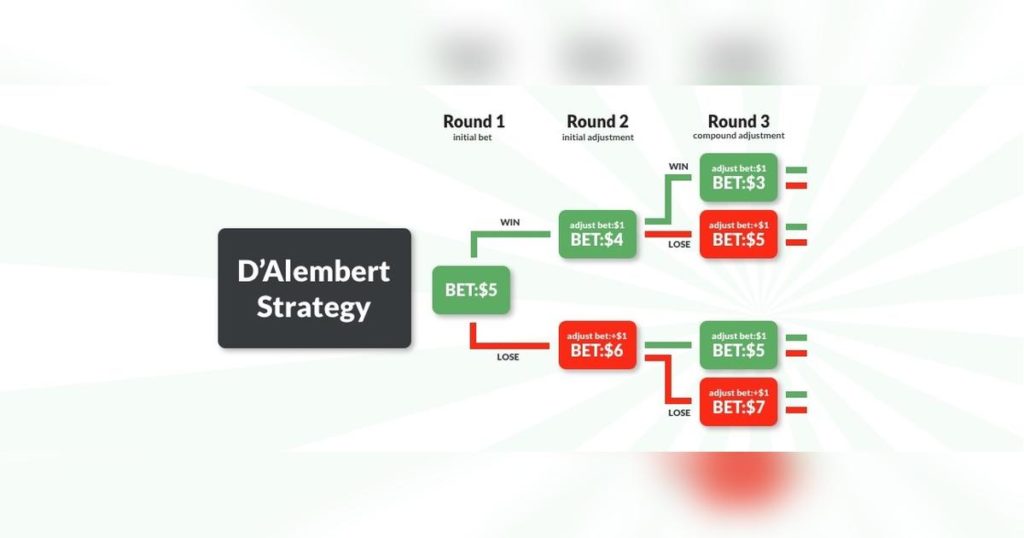In the realm of gambling and betting, the D’Alembert Strategy has garnered popularity as a means to maximize success. Named after the French mathematician Jean-Baptiste le Rond d’Alembert, this betting approach is favored in games of chance like roulette, blackjack, and sports betting. The strategy involves adjusting wagers incrementally based on previous outcomes, making it accessible to both seasoned players and novices. In this article, we delve into the mechanics of the D’Alembert Strategy, analyzing its effectiveness in various scenarios. From its application in roulette to its potential in blackjack and sports betting, we aim to offer a comprehensive evaluation. Whether you’re a casino enthusiast or a sports wagering aficionado, this exploration will equip you with valuable insights to enhance your chances of success using this strategy.

The Origins of the D’Alembert Strategy
The D’Alembert Strategy traces its roots back to the 18th century, owing its name to the esteemed French mathematician Jean le Rond d’Alembert. This prominent figure of the Enlightenment era made significant contributions to various fields, from mathematics and physics to philosophy. While revered for his scientific achievements, the D’Alembert Strategy remains one of his lesser-known legacies.
D’Alembert’s fascination with probability theory and its relevance to games of chance fueled his quest to devise a more structured betting system. He aimed to mitigate the inherent risks and fluctuations associated with gambling. In 1765, he published his work, “Réflexions sur le Jeu,” outlining the principles that now form the foundation of the D’Alembert Strategy.
Central to D’Alembert’s strategy was the concept of equilibrium, positing that games with even odds would eventually balance out over time. According to his belief, a series of losses would increase the likelihood of a subsequent win, and vice versa. Capitalizing on this idea of equilibrium, D’Alembert proposed a progressive betting system.
Under this strategy, when a player experiences a loss, they should increase their next bet by a fixed amount. The rationale behind this approach lies in the expectation that a win will eventually occur, allowing the player to recoup losses more swiftly. Conversely, after a win, the player should decrease the bet by the same fixed amount to safeguard profits and minimize potential losses.
During D’Alembert’s time, the strategy found favor among gamblers, particularly in games featuring even odds, such as roulette and coin flips. Its appeal lay in the simplicity and logical reasoning, drawing many players who sought a more systematic approach to betting.
Understanding the D’Alembert Strategy: A Progressive Betting Approach
At its core, this strategy operates on the concept of progression betting, whereby a player adapts their wagers based on prior outcomes. The fundamental premise is rooted in the belief that, over time, wins and losses will balance out, leading to a break-even point. Central to this strategy is the notion of increasing bets after a loss and decreasing them following a win.
To effectively apply the D’Alembert Strategy, follow these straightforward steps:
- Establish Your Initial Betting Unit: Begin by determining the amount you are comfortable wagering on each round. This initial betting unit sets the foundation for your progressive betting approach.
- Commence with the Chosen Betting Unit: Initiate your betting journey with a wager equivalent to your selected betting unit. This serves as your starting point in the sequence.
- Respond to Outcomes: Depending on the results of each round, adjust your subsequent bet accordingly. If you secure a win, reduce your bet by one unit for the next round. Conversely, if you encounter a loss, increase your bet by one unit for the following round.
- Continue the Process: Repeat this progression for each subsequent round, adapting your bets based on the previous outcomes as you proceed.
Assessing the D’Alembert Strategy in Online Casino Games
The effectiveness of this strategy in online casino games remains a topic of contention, as with any betting approach. While this strategy introduces structure to betting, it is crucial to recognize that online casino games, particularly those driven by random number generators (RNGs), fundamentally operate on principles of chance and unpredictability.
The D’Alembert Strategy finds its common usage in games with even odds, like roulette or blackjack, where players can place bets on outcomes such as red/black, even/odd, or high/low. The strategy relies on the belief in an eventual equilibrium, suggesting that wins and losses will balance out over time.
One of the notable advantages of the D’Alembert Strategy lies in its potential to expedite the recovery of losses when a win occurs, owing to its progressive nature of increasing bets after losses. This aspect appeals to those seeking a methodical approach to mitigate losses and potentially secure profits.
However, it is imperative to acknowledge the limitations of this strategy. While it may appear rational to anticipate alternating wins and losses, each spin or hand in online casino games operates independently, unaffected by past outcomes. The D’Alembert Strategy does not alter the inherent odds or the house edge of the game.
Furthermore, several factors can influence the effectiveness of the D’Alembert Strategy. Considerations such as table limits, available bankroll, and the duration of the gambling session play a pivotal role. Prolonged losing streaks may necessitate a substantial bankroll to sustain increased bets, and reaching table limits or facing a sequence of unfavorable outcomes can lead to significant losses.
D’Alembert Strategy Variations
Classic D’Alembert Strategy
The classic D’Alembert Strategy is a time-tested betting system that has gained popularity over the centuries. It involves adjusting your bet size based on the outcome of each bet. In this variation, you increase your bet by one unit after a loss and decrease it by one unit after a win. This conservative approach aims to minimize losses and maximize wins, providing a systematic and balanced betting experience.
Reverse D’Alembert Strategy
The reverse D’Alembert Strategy offers an alternative approach to the classic version. With this system, you increase your bet by one unit after a win and decrease it by one unit after a loss. It is a more aggressive strategy tailored to those willing to take greater risks in pursuit of bigger wins. This variation aims to capitalize on winning streaks and mitigate losses during losing streaks.
Grand Martingale System
The Grand Martingale System represents a more daring version of the classic D’Alembert Strategy. In this variation, you increase your bet by double the amount of your previous bet after a loss. The underlying concept is to recoup losses quickly and generate a profit when a win eventually occurs. While this system carries higher risks, it also offers the potential for larger winnings. It is suitable for those with a higher risk tolerance who embrace the volatility of their betting experience.
Half D’Alembert System
The Half D’Alembert System is a modified version of the classic strategy designed to offer a more cautious approach. In this variation, you adjust your bet size by half a unit after every win or loss. By reducing the bet increment, this system aims to minimize potential losses while still allowing for modest gains. The Half D’Alembert System is ideal for those seeking a less aggressive strategy and wish to exercise caution while enjoying their betting activities.
D’Alembert Betting Progression System
The D’Alembert Betting Progression System introduces a flexible approach to the strategy, empowering bettors to tailor their betting increments based on their confidence level in each bet. With this variation, you have the freedom to choose the amount by which you increase or decrease your bet. This system offers greater control over your betting strategy, accommodating individual preferences and adapting to changing circumstances.
Applying the D’Alembert Strategy in Practice
While the D’Alembert Strategy appears simple in theory, its practical application demands careful consideration. Let’s explore how this strategy can be employed in various gambling scenarios.
Using the D’Alembert Strategy in Roulette
Roulette, a popular casino game, involves betting on the outcome of a spinning wheel. The D’Alembert Strategy can be applied to roulette by placing even-money bets, such as red or black, odd or even, or high or low numbers.
To implement the D’Alembert Strategy in roulette, it is crucial to establish realistic win and loss limits. This strategy tends to work best in games with a relatively low house edge and a high number of rounds played. However, it is essential to remember that no strategy can guarantee consistent winnings in games of chance.
Implementing the D’Alembert Strategy in Blackjack
Blackjack, a card game blending skill and chance, can also accommodate the D’Alembert Strategy to manage betting sizes. Players can adjust their bets based on previous wins or losses, increasing after a loss and decreasing after a win.
However, it is important to recognize that blackjack strategies typically emphasize card counting and optimal gameplay decisions rather than progressive betting systems like the D’Alembert Strategy. Therefore, players should exercise caution when using this strategy in blackjack and consider other proven techniques for better outcomes.
The D’Alembert Strategy in Sports Betting
Sports betting is another realm where the D’Alembert Strategy can find relevance. However, its application in sports betting requires adaptation to the specific dynamics of this domain. Instead of increasing or decreasing bets by a fixed unit, sports bettors can adjust their wager sizes based on their confidence in a particular outcome.
For instance, if a bet on a certain team loses, a slight increase in the stake for the next game involving the same team can be considered. Conversely, if a bet is successful, a reduction in the stake for the subsequent game may be appropriate. This approach empowers bettors to manage their risk and capitalize on their perceived advantages. It is crucial to exercise proper research and analysis while employing the D’Alembert Strategy in sports betting, as informed decisions are key to success in this unpredictable realm.
FAQs
The D’Alembert Strategy is a betting system named after the French mathematician Jean le Rond d’Alembert. It involves adjusting the size of your bets based on previous outcomes, with the aim of minimizing losses and maximizing wins in games of chance.
In this Strategy, you increase your bet by a fixed unit after a loss and decrease it by the same unit after a win. The strategy is based on the concept of equilibrium, assuming that wins and losses will eventually even out over time.
The effectiveness of the D’Alembert Strategy is a subject of debate. While it can offer a structured approach to betting and help manage losses, it does not alter the underlying odds of the game. It is essential to remember that all betting systems have inherent risks, and no strategy guarantees consistent winnings.
The D’Alembert Strategy is commonly applied to casino games with even odds, such as roulette, where you can bet on red/black, even/odd, or high/low outcomes. It can also be adapted for blackjack and sports betting, though its effectiveness may vary across different games.
Some popular variations of the D’Alembert Strategy include the reverse D’Alembert, Grand Martingale, Half D’Alembert, and D’Alembert Betting Progression System. Each variation modifies the betting approach to suit different risk levels and preferences.
Conclusion
In conclusion, this strategy remains an intriguing and enduring betting approach that has intrigued gamblers for centuries. Conceived by the brilliant mathematician Jean-Baptiste le Rond d’Alembert, this strategy seeks to curtail losses and attain conservative profits through its progressive betting system. Its versatility allows for application in various casino games and sports betting, but it is vital to grasp its limitations and adapt it to the unique dynamics of each game. As with any betting strategy, prudent bankroll management, realistic expectations, and responsible gambling practices are essential for a well-rounded and enjoyable betting experience.









